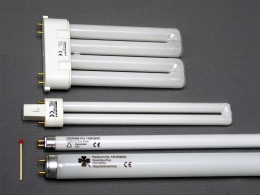These lights come in two primary types: tube lighting and CFL (compact fluorescent lighting).
Fluorescent lights can range in size from tubes multiple feet long to the compact bulbs that are about the size of a standard lamp light bulb.
They are not accepted for recycling in curbside programs and should not be put in the garbage.
There is a recycle system for fluorescent tubes and compact fluorescent bulb disposal, similar to electronic waste disposal. Washington state residents can recycle fluorescent lights and other mercury-containing lights at no charge.
The main categories of lights accepted for recycling by the LightRecycle Washington program are fluorescent tubes (straight or curved), compact fluorescent lights (CFLs), and high intensity discharge lights (HIDs). The program does not accept lighting fixtures or ballasts.
Current recycle sites include:
Thurman Supply:
1807 East Front Street
Port Angeles, WA
Mon-Fri 8 am - 6 pm, Sat 9-5, Sun 10
Swain’s:
602 E 1st St
Port Angeles, WA
Mon-Sat 8 am - 9 pm, Sun 9-6
Around Again:
22 Gilbert Rd.
Sequim, WA
Mon - Sat 10 am - 5 pm
LightRecycle Washington is funded by an environmental handling charge, or “EHC”. An EHC of $0.25 per light will be added to all mercury-containing lights sold at retail stores in Washington state.
Fluorescent tubes and compact fluorescent bulbs contain significant amounts of mercury that can be inhaled or absorbed through the skin. Mercury is a toxic substance harmful to both humans and wildlife. When fluorescent tubes/bulbs are broken (which happens at landfill sites), the mercury contained within is released, creating a risk of exposure to the mercury vapor. Mercury that is exposed to the air can enter the environment and be deposited in lakes and rivers, where it can be transformed into highly toxic methylmercury. Fish and other wildlife can then ingest mercury passing it up the food chain to humans. Once mercury enters the food chain, it is nearly impossible to remove. The United States Environmental Protection Agency estimates that 600 million fluorescent tubes/bulbs are disposed of annually, with over 80% ending up in landfills. Instead of landfilling your lamps, they can now be recycled.
Recycled materials that can be recovered from the tubes/bulbs are aluminum, glass, phosphor and nearly pure liquid mercury.
Information to deal with a broken fluorescent bulb or lamp: http://earth911.com/home-garden/broken-cfl-clean-up/
